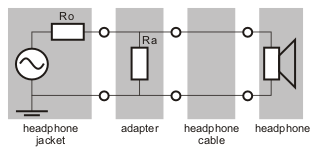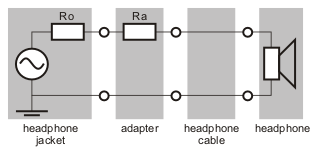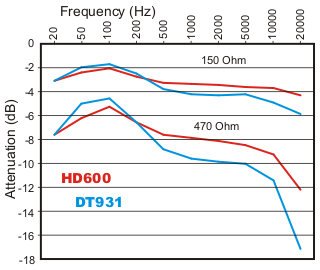MEIER-AUDIO
CORDA
CORDA




HEADPHONE TRICKS
It is easy to just buy a headphone and plug it into any headphone socket. It will instantaneously deliver sound. The quality of this sound, however, in many cases will be far from optimal. Not only does almost every headphone represent by itself a compromise between production costs and sound quality, also the characteristics and quality of the headphone output can have a major impact on music reproduction.
This article presents a few tricks to optimise the sound of your headphone. Some are easy to do, others require some technical soldering skills. It's all up to you have far you want to go.
This article presents a few tricks to optimise the sound of your headphone. Some are easy to do, others require some technical soldering skills. It's all up to you have far you want to go.
BREAK-IN
A headphone straight out of the box often may sound light at the bass and slightly aggressive or diffuse. The electromechanical properties of the drivers haven't settled down yet. It is strongly recommended to run the headphones for 24..100 hours with some continuous bass-heavy music before you start listening. First have the music run for a few hours at a low sound level. Next a few hours at medium level and after this the headphones can be run at a high level for the rest of the break-in.
Break-in improves the mechanical properties of the suspension of the drivers and also "tightens" the windings of the coil. With some headphones the difference is day and night.
Break-in improves the mechanical properties of the suspension of the drivers and also "tightens" the windings of the coil. With some headphones the difference is day and night.
IMPEDANCE OPTIMISATION
HEADPHONE POSITION
It's so easy, but did you ever test for the optimal position of your headphone? With many headphones the soundstage and the balance of sound are notably dependent on the position of the driver to our ears.
Scientific research has shown that our perception of depth is increased when the driver is placed more forward and lower with respect to the entrance of the ear channel.
Experimenting doesn't cost you anything and may improve sound considerably.
Scientific research has shown that our perception of depth is increased when the driver is placed more forward and lower with respect to the entrance of the ear channel.
Experimenting doesn't cost you anything and may improve sound considerably.
The headphone outputs on power amplifiers and receivers are normally directly connected to the loudspeaker outputs. To prevent damage to the headphones and to the amplifier, resistors are placed in between. The effective output impedance thereby is high with values between 200 and 600 Ohm .
The output impedances of headphone amplifiers, CD-players, and portable players have much lower values, generally below 10 Ohm.
The output impedance Ro of a headphone jacket has a major impact on the sound. Not only does it reduce the voltage seen by the headphone, it also changes the frequency characteristics of the sound.
The impedance of the headphone, Zphone(f), is frequency dependent and a sinus signal of frequency f will be attenuated by the output impedance by a factor:
| Zphone(f) / (Zphone(f)+Ro) | < 1
The output impedances of headphone amplifiers, CD-players, and portable players have much lower values, generally below 10 Ohm.
The output impedance Ro of a headphone jacket has a major impact on the sound. Not only does it reduce the voltage seen by the headphone, it also changes the frequency characteristics of the sound.
The impedance of the headphone, Zphone(f), is frequency dependent and a sinus signal of frequency f will be attenuated by the output impedance by a factor:
| Zphone(f) / (Zphone(f)+Ro) | < 1
Often Zphone(f) has a maximum at the lower frequencies and therefore the attenuation of the lower frequencies is less than that of the higher frequencies.
As an example the figure shows the attenuation at various frequencies for the Sennheiser HD600 and the Beyerdynamic DT931 at output impedances of 150 and 470 Ohm.
With such headphones, increasing the output impedance makes them sound darker / less bright.
An old international audio standard "prescripes" a value of 120 Ohm.
As an example the figure shows the attenuation at various frequencies for the Sennheiser HD600 and the Beyerdynamic DT931 at output impedances of 150 and 470 Ohm.
With such headphones, increasing the output impedance makes them sound darker / less bright.
An old international audio standard "prescripes" a value of 120 Ohm.
If your headphone sounds dark and muddy and is driven by an power amplifier or receiver, you might try to decrease the effective output impedance. This also can be done by an adapter, but this time the resistors are placed in parallel with the audio-channels. The effective output impedance becomes (without proof)
Ro * Ra / (Ro + Ra).
The value of the resistor should be 0.1 .. 1 times the impedance of the headphone drivers to have a noticable effect. Be aware that with very low values of Ra your amplifier has to deliver a much higher current signal to obtain the same sound pressure. Also be aware that the resistors should be able to dissipate enough heat!
Note: The impedance of magnoplanar headphones is almost frequency independent and therefore their sound can not be tuned as described above.
Ro * Ra / (Ro + Ra).
The value of the resistor should be 0.1 .. 1 times the impedance of the headphone drivers to have a noticable effect. Be aware that with very low values of Ra your amplifier has to deliver a much higher current signal to obtain the same sound pressure. Also be aware that the resistors should be able to dissipate enough heat!
Note: The impedance of magnoplanar headphones is almost frequency independent and therefore their sound can not be tuned as described above.
If your headphone sounds sharp and aggressive, you might consider increasing the effective output impedance by placing an adapter between headphone jack and headphone. The adapter has a resistor placed in series with each audio-channel of the headphone. The effective output impedance is the sum of the output impedance of the jacket and the value of the resistor
(Ro + Ra).
Note: The value of the resistor should not be higher than 3 till 4 times the impedance of the headphone drivers. Further increases do hardly effect sound.
(Ro + Ra).
Note: The value of the resistor should not be higher than 3 till 4 times the impedance of the headphone drivers. Further increases do hardly effect sound.